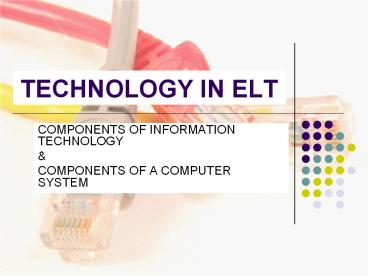Components of Internet - PowerPoint PPT Presentation
Title:
Components of Internet
Description:
xsdsfsf – PowerPoint PPT presentation
Number of Views:283
Title: Components of Internet
1
TECHNOLOGY IN ELT
- COMPONENTS OF INFORMATION TECHNOLOGY
- COMPONENTS OF A COMPUTER SYSTEM
2
COMPONENTS OF INFORMATION TECHNOLOGY
3
An information system has five parts
- 1. People
- The most important part as they make end-users
more productive.
4
An information system has five parts
- 2. Procedures
- Refer to rules or guidelines people follow when
using software, hardware and data. - Documented in manuals written by computer
specialists. - Provided by software/hardware manufacturers of
the product.
5
An information system has five parts
- 3. Software
- Computer software is the term for programmes or
sets of computer instructions. - Written in special computer language that enable
a computer to accomplish a given task. - It consists of step-by-step instructions, which
the computer can use to convert data into
information.
6
An information system has five parts
- 4. Hardware
- Computer components that are physical, touchable
pieces or equipment. - It consists of the system unit, input/output,
secondary storage and communication devices. - 4 types of computers
- 1. Supercomputers the most powerful type of
computers. - 2. Mainframe occupy specially wired,
air-conditioned rooms. - 3. Minicomputers desk-sized machines used for
specific purposes. - 4. Microcomputers include the desktop,
notebook and personal digital assistant.
7
SUPERCOMPUTER
8
MAINFRAME
9
MINICOMPUTER
10
MICROCOMPUTER
11
An information system has five parts
- 5. Data
- Raw, unprocessed facts including text, numbers,
images and sounds. - Data describes something that is stored
electronically in a file. - Examples
- Document files created by word processors
- Worksheet files crated by spreadsheets
- Database file created by database management
programmes - Presentation files created by presentation
graphics programmes
12
COMPONENTS OF A COMPUTER SYSTEM
- A computer system has three main components
- Hardware
- Software
- Warmware
- A computer system performs 4 important tasks
(Sharp, 200535) - Receiving input figures, facts or sets of
instructions - Storing information place in memories
- Processing the data act on the information
- Outputing the information process and generate
results
13
TASK OF COMPUTER SYSTEM
CPU
INPUT
OUTPUT
STORAGE
14
4 MAIN ASPECTS OF DATA HANDLING
- 1. Input devices
- - accept data or commands in a form that the
computer can use they send the data or commands
to the processing unit. - 2. The Processor
- - known as CPU, has electronic circuitry that
manipulates input data into information that
people require. The CPU execute computer
instructions. - 3. Output Devices
- - display the people the processed data
information in understandable and usable form - 4. Storage
- - means secondary storage consists of secondary
storage devices such as hard disk, diskettes,
pendrives. - - can store data and programmes outside the
computer itself. - - these devices supplement memory or primary
storage, can hold data or programmes temporarily.
15
1. What is Input?
- Input refers to any data or instructions that are
used by a computer. All computer processing
requires data. - Whenever you use computer or application
software, you are providing input. You typically
use a keyboard to type text and a mouse to issue
commands.
16
Input Devices
- Keyboard
- Mouse
- Joystick
- Touch Screen
- Light Pen
- Scanner
- Bar code readers
- Digital cameras
- Video cameras
- Graphic tablets
- Voice recognition systems
17
2. What is Process?
- The computer manipulates the data to create
information. - Information refers to data processed into a form
that has meaning and is useful.
18
Processing Devices/System Units
- Mother board/System
- CPU/Microprocessor
- Memory RAM, ROM
- Expansion Slots and Cards
- System Clock
- Bus Lines
- Ports and Cables
19
What is Output?
- Is a processed data or information.
- Output devices provide output to people by
translating what the computer has processed into
a form that people can understand and use.
20
Output Devices
- Monitor CRT, LCD
- LCD projector
- Video scan converter
- Printer
21
4. What is Storage?
- Information can be stored in a computer for
future use. - All computers have a hard disk drive to store
programmes and data.
22
Storage Devices
- Hard Disk
- Removable Disks
- Floppy Drive
- CD-ROM, R, RW
- DVD-ROM, R, RW
- Pen Drive, Thumb Drive, Zip Drive
- External Hard Disk
23
TEST YOUR UNDERSTANDING!
24
Visualize these components and draw them!
- Keyboard
- Mouse
- Monitor
- Speaker
- Webcam
- Printer
- CPU
- Mother board
- Slot Card
- RAM
- USB port
- PS2 port
- Parallel port
- Serial port
- Floppy Drive
25
COUNT!
- 1B _______ BITS
- 1KB _______ B
- 1MB _______ KB
- 1GB _______ MB
- 1TB _______ GB
- 700MB _____ GB
- 128MG _____ KB
- 512MG _____ GB
- 16GB _____ MB
- 256KB _____ MG
- Binary system works on ____ digits, i.e. _____
and ______. - Frequency wave is based on ______ and ______.
- Draw them.
26
- APPLICATION SOFTWARE
27
2 CATEGORIES
- 1. General-purpose
- - also known as basic applications
- - includes browsers, word processors,
spreadsheets, database management systems and
presentation graphics. - 2. Special-purpose
- - also known as advanced applications, include
multimedia, web authoring, graphics, virtual
reality, artificial intelligence
28
4 general-purpose software
- Word processors
- Spreadsheets
- Database Management Systems
- Presentation Graphics































